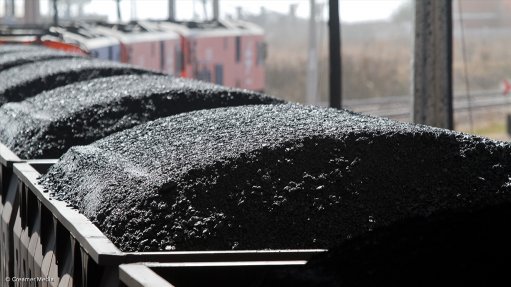
CONGESTED Rail capacity on Transnet’s coal line has long been cited as a constraint to exports, which the leadership of the utility is cognisant of
South Africa’s rail-based coal export constraints seem likely to continue, notes industry body Minerals Council South Africa.
One of the biggest constraints to coal exports is the Overvaal tunnel, in Mpumalanga, a bottleneck point for Transnet-owned and operated railroads transporting export coal to the Richards Bay Coal Terminal, in KwaZulu-Natal.
According to the Minerals Council South Africa’s Facts and Figures 2020 booklet, published in October, there was hope that Transnet would increase capacity at the tunnel, but that “those hopes have been dashed since the [State-owned] utility has decided to permanently put the project on hold”.
The proposed expansion to the Overvaal project, conceptualised in 2008, was supposed to involve the construction of a new tunnel, about 20 m south of the existing tunnel.
The proposed new tunnel would have been about 3 994 m in length and would have increased export capacity on the rail line from 81-million tons to 132-million tons a year.
The existing Overvaal tunnel, completed in 1976, is situated between Ermelo and Piet Retief on the Richards Bay coal line. The line has a stretch of single track on the edge of the escarpment at Overvaal, where there is only one tunnel on the single track.
About 40% of all rail freight in South Africa has to pass through the single-track Overvaal tunnel. As such, a significant portion of the county’s international primary commodity exports pass through this tunnel – including vast quantities of coal.
For several years, the construction of a second tunnel adjacent to the existing tunnel was found to be the preferred option, although the project never broke ground.
Taking Action
Rail capacity on Transnet’s coal line has long been cited as a constraint to exports, which the leadership of the utility is cognisant of.
The leadership of Transnet and the Minerals Council, along with Public Enterprises Minister Pravin Gordhan and various coal sector CEOs, met for a full-day detailed workshop in August as part of ongoing engagements to ensure operational improvements on the railway network.
In a statement issued by the Minerals Council in August, the discussions were described as “frank and open, with the aim of ensuring [that] Transnet is able to stabilise operations”.
Transnet and the Minerals Council have agreed to collaborate on several key areas to ensure operational improvements to get back to target performance levels in the short term.
One of these targets is the establishment of smaller working teams focused on the different commodity groups by corridor to address corridor-specific issues. Better engagement on yearly maintenance shutdowns is being targeted, and the collaboration aims to collectively work to ensure faster recovery from derailments.
Greater collaboration is also being sought on security issues to implement technologies to reduce theft and vandalism of infrastructure.
Increasing Reliance on Exports
South Africa derives more than 70% of its energy requirements from coal. State-owned power utility Eskom, the country’s biggest domestic consumer of coal, is on a path towards using green technologies to generate electricity.
Therefore, in the coming years, its demand for coal will decline significantly, the Minerals Council said in the Facts and Figures 2020 booklet.
China has emerged as a key market for South African coal, with exports having resumed in late 2020 after a five-year hiatus. The country reached the status of being South Africa’s biggest coal market in February this year.
Trade tensions between Australia and China have also presented an opportunity for South African coal exporters, since China unofficially banned Australian coal in October 2020.
Although China has opened as a renewed market for South African coal, exporters still face strong competition from midcalorific Australian coal in other regions. Australian coal is now competing directly with South African coal in its traditional export markets, particularly in India and other South Asian markets.